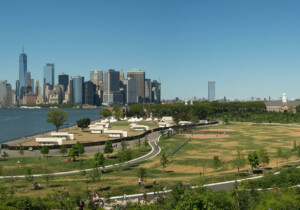Many New Yorkers know the Hudson Valley from weekend trips to Hudson or Beacon, but the urban designers at Columbia University want to introduce new ways of thinking about the diverse and complex region.
Famous for rolling hills immortalized by the Hudson River School, the mostly rural five-state region is home to prisons, 19th-century asylums, back-to-the-land hipsters, art museums, and 13 cities, too. Tomorrow, students and faculty from the Graduate School of Architecture, Planning and Preservation (GSAPP) at Columbia University will join community leaders in Poughkeepsie to celebrate the opening of a pop-up exhibition featuring urban design proposals for a more resilient and just Hudson Valley.
Justice in Place is the culmination of student projects that explore how equity and justice can be fostered spatially. Student projects explored these themes through incarceration and education; health; historic preservation; landscape; and food systems. The work will be on display through January 31 at the Mid-Hudson Heritage Center.
The projects are part of GSAPP’s Hudson Valley Initiative (HVI), a research platform and archive that combines the strengths of GSAPP’s programs to build partnerships and projects in the region, as well as facilitate inquiry into the American landscape more broadly.
“Central to the whole urban story of the region is the story of the river itself. Thinking about water as the economic driver provides rich ground in which to think about urban design,” said landscape architect and HVI director Kate Orff. “The Hudson Valley is extraordinarily beautiful, but there’s also this dramatic inequality,” added HVI assistant director David Smiley. “This is out backyard, and we need to take the research here to another level.”
Through the HVI, GSAPP has extended and deepened its relationship to the region. The projects, Orff and Smiley said, aim to benefit both students and the community: Using an applied research framework, students incorporate community feedback with what they’ve learned in class into activist proposals for the study area. In building longstanding regional ties, the HVI also counteracts a common problem with ostensibly community-engaged projects—students parachute in for a semester, create a project with little follow-up, and leave the community once they’ve earned their credits. In contrast to this method, work through the HVI from previous semesters informs current projects.
Since the end of World War II, the once-prosperous region has experienced a slow and steady slide in its economic fortunes. Although recent migrants and investment have revived towns like Cold Spring and Hudson, but left others behind. The videos here showcase work from past urban design studios centered on Newburgh and Beacon.
Orff and Smiley said GSAPP is adding an optional fourth semester onto the three-semester urban design program, so the “same projects hit the ground running,” said Orff. “We need to dig deeper in these places.”
The Justice in Place: Design for Equity & Regional Currents opening party is tomorrow, January 28, at the Mid-Hudson Heritage Center from 2:00 p.m. – 5:00 p.m. More information can be found here.










